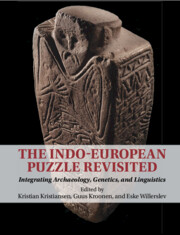Book contents
- The Indo-European Puzzle Revisited
- The Indo-European Puzzle Revisited
- Copyright page
- Contents
- Figures
- Tables
- Contributors
- Preface
- Introduction
- Part I Early Indo-European and the Origin of Pastoralism
- Part II Migratory Processes and Linguistic Dispersals between Yamnaya and the Corded Ware
- 5 The Corded Ware Complex in Europe in Light of Current Archaeogenetic and Environmental Evidence
- 6 Emergent Properties of the Corded Ware Culture: An Information Approach
- 7 Linguistic Phylogenetics and Words for Metals in Indo‑European
- 8 Word Mining: Metal Names and the Indo-European Dispersal
- Part III The Cultural and Linguistic Significance of Bell Beakers along the Atlantic Fringe
- Part IV The Bronze Age Chariot and Wool Horizons
- Part V Kinship Systems, Marriage, Fosterage, Free, and Unfree
- Concluding Reflections
- Index
- References
8 - Word Mining: Metal Names and the Indo-European Dispersal
from Part II - Migratory Processes and Linguistic Dispersals between Yamnaya and the Corded Ware
Published online by Cambridge University Press: 29 April 2023
- The Indo-European Puzzle Revisited
- The Indo-European Puzzle Revisited
- Copyright page
- Contents
- Figures
- Tables
- Contributors
- Preface
- Introduction
- Part I Early Indo-European and the Origin of Pastoralism
- Part II Migratory Processes and Linguistic Dispersals between Yamnaya and the Corded Ware
- 5 The Corded Ware Complex in Europe in Light of Current Archaeogenetic and Environmental Evidence
- 6 Emergent Properties of the Corded Ware Culture: An Information Approach
- 7 Linguistic Phylogenetics and Words for Metals in Indo‑European
- 8 Word Mining: Metal Names and the Indo-European Dispersal
- Part III The Cultural and Linguistic Significance of Bell Beakers along the Atlantic Fringe
- Part IV The Bronze Age Chariot and Wool Horizons
- Part V Kinship Systems, Marriage, Fosterage, Free, and Unfree
- Concluding Reflections
- Index
- References
Summary
The first use of metals in the production of objects among human societies was undoubtedly a defining event with a profound, irreversible impact on craftsmanship, agriculture, trade, warfare, and other cultural and political phenomena. The continuous refinement of metallurgical practice, including the introduction of new metals, has left behind some of the most conspicuous and important archaeological remains. Furthermore, the linguistic and archaeological evidence provided by metals can be combined to cast light on the relative placement of reconstructed languages in time and space through the use of linguistic palaeontology (cf. already Schrader 1883). For the study of the expansion of the Indo-European (IE) languages, examining the inventory of metallurgical vocabulary is thus highly relevant – not only for dating and locating the dissolution of each language, but also for determining the branching and spread of the successive daughter languages, and how they were influenced by foreign languages.
- Type
- Chapter
- Information
- The Indo-European Puzzle RevisitedIntegrating Archaeology, Genetics, and Linguistics, pp. 105 - 126Publisher: Cambridge University PressPrint publication year: 2023

